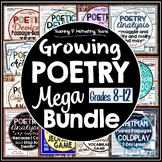Literary Devices Test | Poetry Assessment
- Zip
What educators are saying
Also included in
- Your students will love this huge, editable collection of fun, differentiated, and challenging poetry lessons. They'll particularly enjoy the games and activities, while you'll love the standards-based, rigorous, and engaging resources. Also includes an end-of-unit test. This is my largest poetry buPrice $22.00Original Price $29.50Save $7.50
- Welcome to a huge bundle of great lessons and teaching resources that will give you a firm foundation for your lesson planning. Engaging lessons you'll love to teach, and your students will love to learn!I've been asked to create a larger bundle - and here it is! With this huge resource, you'll havePrice $145.96Original Price $162.18Save $16.22
Description
⚜This poetry and literary devices test is in multiple choice format and recommended for grade 8 through high school students. It is a resource you'll use again and again!⚜
➜This resource is available at a reduced price as part of my Poetry Mega-Bundle for Middle and High School. Check it out!
ELA CCSS & ACT QC aligned - 20 questions based on four separate poems, this assessment is perfect for a poetic devices - figurative language test. The four poems provide a state-test-like format wherein your students apply their knowledge of the standards and concepts they have learned to four pieces they have not studied. Of course, you also have the choice to study one or all of the poems beforehand - but, in preparation for state testing, I normally present my students with at least three out of four "cold" reads.
Listed on the first page are the concepts that are assessed. This way you have an easy reference sheet to use as you develop your unit, learning targets, daily lessons. This summative poetry assessment makes it easy to "begin with the end in mind."
Some of the vocabulary includes: personification, simile, genre, ballad, ode, narrative, etc. All tested concepts are listed on one of the preview pages.
Be sure and check out some of my other products! Just click on the handy links provided below. :-D
⚜⚜⚜⚜⚜⚜⚜⚜⚜⚜⚜⚜⚜⚜⚜⚜⚜⚜⚜⚜⚜⚜⚜⚜⚜⚜⚜⚜⚜⚜⚜⚜⚜⚜⚜⚜⚜⚜⚜⚜⚜⚜⚜⚜
More Products for You and Your Students to Love:
Lessons with Song Lyrics
1. My Life Symbolized by Song Titles
2. Coldplay's "Violet Hill" Song Lyric Analysis Lesson
ELA Games
1. Literary/Poetic Devices "Tab-shoo"
2. Literary Elements "Tab-shoo"
3. Characterization: Character Portrayal Game
4. "Name That Tone" - Author's Tone Game
5. Hangman Template (a step-by-step easy approach to the process of the game)
Poetry
1. Emily Dickinson's "Because I Could Not Stop for Death" Close Reading
2. E.E. Cummings Poem "maggie and milly and molly and may
Literary Criticism
How to Critique Literature through Literary Criticism (ACT QC)
Secondary and Junior High Poetry Unit and Figurative Language Summative Assessment.







